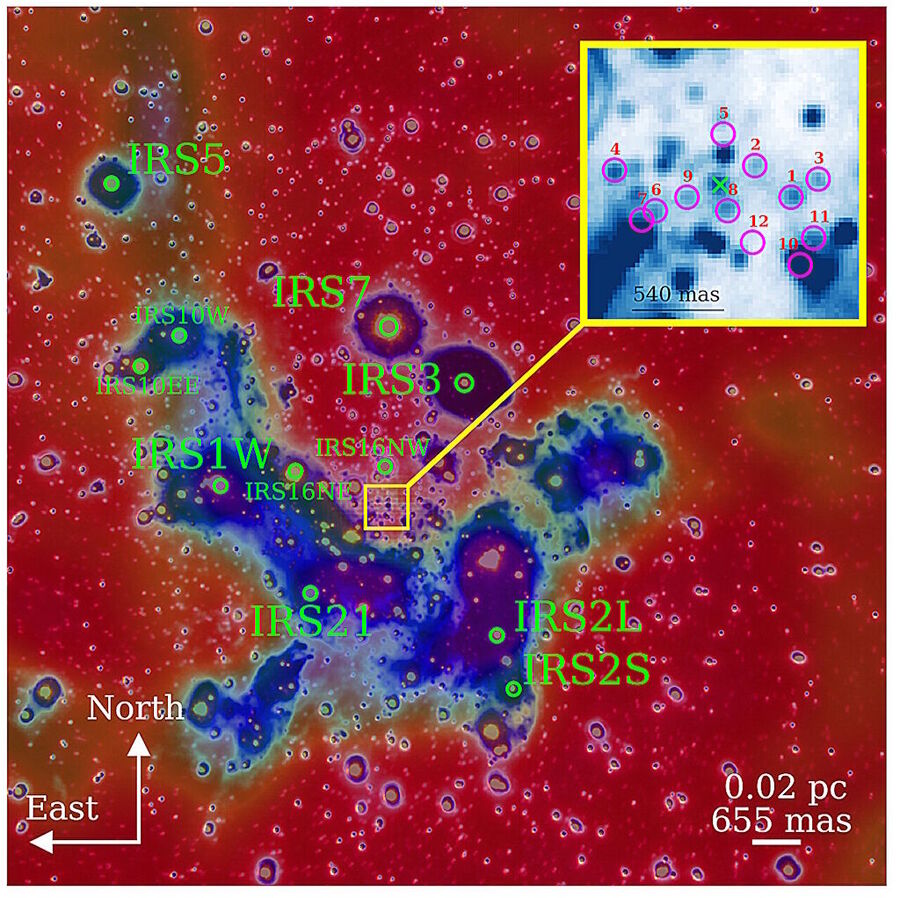Observational astronomy shows that newly discovered young stellar objects (YSOs) in the immediate vicinity of the supermassive black hole Sagittarius A* located in the center of our galaxy behave differently than expected. They describe similar orbits to already known young evolved stars and are arranged in a particular pattern around the supermassive black hole.

© Astronomy & Astrophysics (2024). DOI: 10.1051/0004-6361/202449729Multiwavelength finding chart of the inner ≈0.4 pc of the Galactic center observed in the K-band (red) and L-band (blue) observed with NACO (VLT).
It involved researchers from the University of Cologne, Masaryk University in Brno (Czech Republic), Charles University in Prague (Czech Republic), the Academy of Sciences of the Czech Republic and the Max Planck Institute for Radio Astronomy in Bonn.
Around 30 years ago, highly dynamic stars were discovered in the immediate vicinity of the supermassive black hole Sgr A* at the center of the Milky Way.
These stars, also known as S stars, circumnavigate the supermassive black hole with speeds of several thousand kilometers per hour in a few years. The stars are surprisingly young and their presence is puzzling, as according to popular theories one would expect only old and dim stars in the immediate vicinity of the supermassive black hole.

© Astronomy & Astrophysics (2024). DOI: 10.1051/0004-6361/202449729Brγ line evolution of D9 between 2005 and 2019 observed with SINFONI. D9 can be identified in every epoch with a proper motion of about 250 km s−1. The related distance of D9 and the LOS velocity is listed in Table 4. Sgr A* is marked with a green cross (×). Here, north is up and east is to the left. For the epoch representing 2015 and 2016, there are remnants to the north of D9, which are related to insufficient instrument response of the observations.
While this theory has not been confirmed, it has been unclear for a long time exactly what kind of object this might be. In recent years, mounting evidence has shown that it could be a YSO surrounded by a dusty cloud.
In addition to the S stars, researchers have currently been conducting research on a dozen objects in the direct vicinity of the supermassive black hole which also have very similar properties. They found out that the objects were even significantly younger than the already known high-speed stars.
"Interestingly, these YSOs exhibit the same behavior as S stars. This means that the YSOs circumnavigate the supermassive black hole with speeds of several thousand kilometers per hour in a few years," explained Dr. Florian Peißker from the University of Cologne's Institute for Astrophysics and corresponding author of the study.
"The S stars were found to be surprisingly young. According to conventional theories, the additional presence of a stellar kindergarten composed of YSOs is completely unexpected," added Dr. Peißker.
Furthermore, this group of high-velocity objects consisting of YSOs and S stars appears to resemble a chaotic swarm of bees at first glance. However, in the same way a swarm of bees has a pattern and regular formations, so do the YSOs and the S stars.
In this way, the researchers were able to demonstrate that YSOs as well as S stars are arranged in a specific, organized way within three-dimensional space.
"This means that there are specific preferred star constellations. The distribution of both star variations resembles a disk, which gives the impression that the supermassive black hole forces the stars to assume an organized orbit," said Peißker.
More information: F. Peißker et al, Candidate young stellar objects in the S-cluster: Kinematic analysis of a subpopulation of the low-mass G objects close to Sgr A*, Astronomy & Astrophysics (2024). DOI: 10.1051/0004-6361/202449729
Source link

